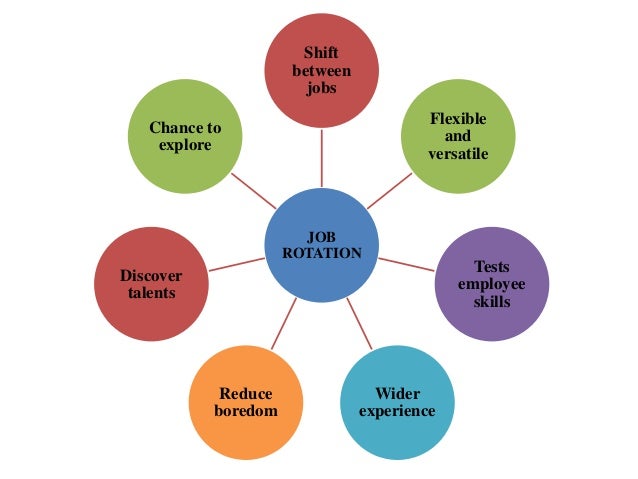Effect
of JOB ROTATION to organizations and its employees
Job rotation is the process of
shifting employees from one job within an organization to another in order to
expose them to different aspects of the business. Formal job rotation programs
provide tailored assignments for talented employees to round out their
experience. By exposing employees to new working experiences, they can develop
their abilities in order to improve their job satisfaction and
contribute to the company in many different ways.
Job rotation is not an easy process
because some people do not like to shift from their comfort zone and may not be
capable of adapting to a new work environment. However, if a company can
implement this strategy properly, it will benefit both employees and the
organization.
source of figure: https://image.slidesharecdn.com/jobrotation-160620124748/95/job-rotation-2-638.jpg?cb=1466426932
Advantages of job rotation to the employees and organization.
§
Employees
gain a broader range of job experience and knowledge, allowing them to
specialize in a variety of fields. The organization can retain talented
employees as job satisfaction and job security have improved.
§
Job
rotation encourages collaboration since employees discover different working
styles and get to know their coworkers, which leads to success in team work.
§
This
can be used as a back-up plan if an employee quits or takes a leave of absence
unexpectedly. For the required task, the organization can replace employees
with no delay
HRM plays a crucial role in
implementing the job rotation strategy in the workplace. The ultimate goal of
job rotation should be to lead the company to success through employee
motivation, satisfaction, flexibility, and retention.
How to successfully employ the process of job rotation
§
Identifying
the purpose of job rotation in the organization beforehand and recognizing the
individuals who have the ability to shift to a different task, as well as
volunteering to do so, is critical.
§
Employees
should be trained before switching to a new task, since this will boost their
confidence in working in a new field.
§
Monitoring
their performance and providing them with feedback can help them succeed in
this technique
Many organizations throughout the world have used this
strategy in various ways to achieve various goals.
Example :
Edelman
There
are many different job rotation programs at Edelman, an American PR and
marketing consultancy firm, they have a rotation
program for their high-performing,
high-potential employees. Employees who are selected are sent to an
international location to work, live, and learn for up to 18 months.
The idea behind
Edelman’s program is to give people the opportunity to learn from varying
perspectives around the world and to diversify their work experience (to ultimately
better serve the company’s clients)
Anon., n.d. AIHR Digital. [Online]
Available at: https://www.digitalhrtech.com/job-rotation/
[Accessed 28 7 2021].
Anon., n.d. MSG
Management study guide. [Online]
Available at: https://www.managementstudyguide.com/tips-for-successful-job-rotation.htm
[Accessed 26 7 2021].
Golemanova, R., 2021. Hourly.
[Online]
Available at: https://www.hourly.io/post/job-rotation-pros-and-cons-for-your-business
[Accessed 26 7 2021].

great explanation Heamaka. The importance of job rotation is to provide a good platform for equity and fairness. They provide a challenging environment and increase employee and employee performance. Extrinsic needs of workers at all levels are the effect of job rotation which ensures that both the intrinsic are adequately provided. This is because it develops organizations integrated policy, procedure and practice. It is an important signal of organization culture and it is important to the successful recruitment and retention of high caliber work force with adequate knowledge, skill and ability that supports the organization strategic goals. Thanks for sharing.
ReplyDeleteHi Hemalka. Well explained it. And i like to add some knowledge to it. Job Rotation is a management approach where employees are moved between at least two tasks or jobs at normal time frames to expose them to new experiences of an organization. It helps to reducing the flatness of the job role, succession planning and also Creating a job-fit complete employee. There are some benefits of Job rotation like It helps to reveal the employees hidden talents, Employee motivation, Increases Satisfaction and Decreases Attrition Rate and Helps Individuals Explore Their Interests.
ReplyDeleteAgreed Heamaka..even we are experiencing the tired of doing same job for a long time. Rotation gives a kick to work more effectively. Thanks for sharing this
ReplyDeleteHi Hemaka,
ReplyDeleteGreat explanation. As you explained in this blog, the job rotation will positively impact organizational growth and increase the richness of skill. With the current business context in the manufacturing sector, the main challenges are short order quantities and agility. To facing agility challenges, the main contributor will be the skills of the employees, so job rotation can develop employee's skills and can face short order quantities and agility business environments positively.
To get the benefit of this concept better, make the rotation plan in prior and make the training plan. With training and employees can easily adapting to their new job-role, this can reduce the productivity loss in the learning curve
Job rotation helps the organizations to build All-rounders. It increases
ReplyDeletethe knowledge, the skills and the employees also get motivated with the change of job role. Therefore agree on your view in the article.
Job Rotation is a management method where employees are transferred between two or more assignments or tasks from time to time to expose them to all organizational structures. It is a pre-planned approach to assessing the skills and abilities of employees to put them in the right place.
ReplyDelete